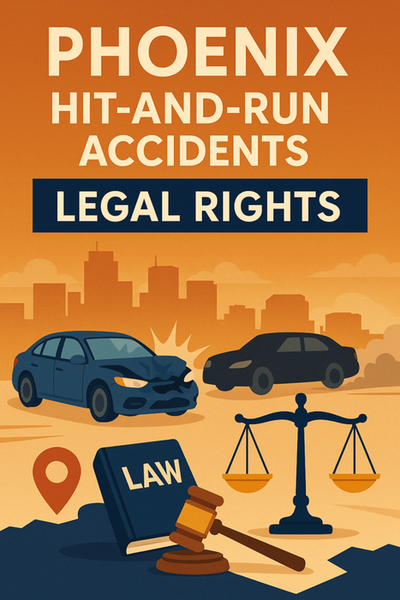Hit-and-run accidents represent some of the most frustrating cases for victims in the Phoenix metropolitan area. When a driver flees the scene after causing a collision, victims face unique challenges in pursuing medical treatment, vehicle repairs, and fair compensation.
Understanding Arizona’s Hit-and-Run Laws
Under Arizona Revised Statute § 28-661, drivers involved in accidents resulting in injury or death must:
- Immediately stop at the scene or as close as possible
- Provide reasonable assistance to injured persons
- Exchange information with other involved parties
- Report the accident to law enforcement
Failure to comply with these requirements constitutes a “hit-and-run” offense. When injuries occur, this becomes a Class 5 felony punishable by up to 2 years in prison. If a hit-and-run results in death, it’s classified as a Class 2 felony with penalties including up to 12.5 years imprisonment.
Phoenix Hit-and-Run Statistics
According to data from the Arizona Department of Transportation (ADOT), Maricopa County consistently leads the state in hit-and-run crashes, with Phoenix accounting for the majority of these incidents:
- Approximately 15,000 hit-and-run crashes occur annually in Maricopa County
- Over 50 people die each year in Arizona from hit-and-run accidents
- Nearly 92% of hit-and-run drivers who cause fatalities or serious injuries are eventually identified
Common Locations for Phoenix Hit-and-Run Accidents
Certain Phoenix areas see higher concentrations of hit-and-run incidents:
- The I-17 corridor
- Central Phoenix, particularly near the downtown entertainment district
- Major intersections along Camelback Road
- Areas near Arizona State University’s downtown campus
- The Broadway Road corridor in South Phoenix
Steps to Take After a Hit-and-Run in Phoenix
If you’re the victim of a hit-and-run accident in Phoenix, take these important steps:
- Contact Phoenix Police Department immediately (602-262-6151 or 911 for emergencies)
- Document everything – Take photos of vehicle damage, the accident scene, and any visible injuries
- Identify witnesses – Collect contact information from anyone who saw the accident
- Seek medical attention – Visit a healthcare provider even if injuries seem minor
- Report to your insurance – Notify your carrier about the hit-and-run
- Consult with an attorney – GLG Personal Injury Lawyers can help navigate your legal options
Investigating Phoenix Hit-and-Run Accidents
The Phoenix Police Department’s Vehicle Crimes Unit specializes in hit-and-run investigations. These specialized detectives employ several techniques to identify fleeing drivers:
- Reviewing traffic camera footage
- Canvassing for business surveillance video
- Examining vehicle debris for identifying marks
- Working with local body shops that may repair the suspect vehicle
- Issuing public alerts with partial descriptions or license plates
Additionally, Arizona DPS officers assist in investigations on state highways and interstates throughout the Phoenix metropolitan area.
Insurance Coverage for Phoenix Hit-and-Run Victims
Hit-and-run accidents highlight the importance of comprehensive auto insurance coverage. For Phoenix residents, several coverage types may apply:
- Uninsured Motorist (UM) Coverage: Protects you when the at-fault driver flees or lacks insurance
- Personal Injury Protection (PIP): Covers medical expenses regardless of fault
- Medical Payments Coverage: Helps with immediate medical costs
- Collision Coverage: Pays for vehicle repairs minus your deductible
The Arizona Department of Insurance recommends Phoenix drivers carry uninsured motorist coverage specifically because of the high rate of hit-and-run accidents in Maricopa County.
Victim Compensation Resources in Phoenix
Hit-and-run victims in Phoenix may qualify for assistance through:
- The Arizona Criminal Justice Commission’s Victim Compensation Program
- The Arizona Health Care Cost Containment System (AHCCCS) for qualifying individuals
- Non-profit organizations like the Maricopa Health Foundation
For comprehensive information about resources available to hit-and-run victims, visit GLG’s Phoenix Auto Accident Guide.
Legal Options for Phoenix Hit-and-Run Victims
Victims of hit-and-run accidents in Phoenix have several potential legal avenues:
- Criminal Case: If the driver is identified, the Maricopa County Attorney’s Office may pursue criminal charges under A.R.S. § 28-661.
- Civil Lawsuit: Victims can pursue compensation through a personal injury lawsuit against the identified driver in Maricopa County Superior Court.
- Insurance Claims: Filing claims with your own insurance and potentially the at-fault driver’s insurance if they’re eventually identified.
Understanding these options and their timelines is critical. GLG Personal Injury Lawyers in Phoenix can provide guidance specific to your situation.
The Statute of Limitations for Phoenix Hit-and-Run Claims
Under Arizona law, hit-and-run victims generally have:
- Two years from the accident date to file a personal injury lawsuit
- Three years for property damage claims
- Six months to file a notice of claim if a government entity shares liability (such as for dangerous road conditions)
These deadlines make prompt action essential for protecting your legal rights.
Preventing Hit-and-Run Accidents in Phoenix
The Arizona Governor’s Office of Highway Safety and the Phoenix Police Department recommend these strategies to reduce hit-and-run incidents:
- Installing dashboard cameras in vehicles
- Supporting increased traffic enforcement in high-risk areas
- Advocating for enhanced penalties for hit-and-run drivers
- Promoting public awareness campaigns like “Stay at the Scene”
Conclusion
Hit-and-run accidents in Phoenix create unique challenges for victims seeking justice and compensation. With the right knowledge, insurance coverage, and legal assistance, victims can navigate these difficult situations more effectively. If you’ve been injured in a hit-and-run accident, documenting everything, reporting promptly, and consulting with experienced legal counsel are the most important steps toward protecting your rights and securing fair compensation.



